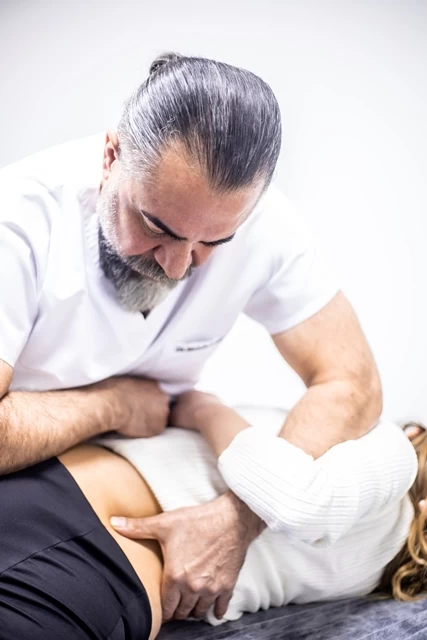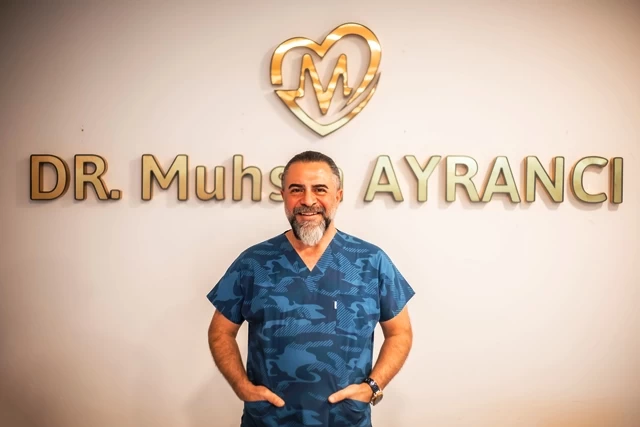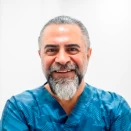
The Basic Principle of Osteopathic Treatment: “There is no disease, only the patient exists.”
- The Basic Principle of Osteopathic Treatment: “There is no disease, only the patient exists.”
- What is Osteopathy?
- Most Commonly Used in Spinal Problems
- Osteopath Assists the Patient with 3 Different Approaches
- Diseases Benefiting from Osteopathic Treatments:
- How is Osteopathy Different from Physical Therapy?
- How Long Does Osteopathy Treatment Take?
- How is Osteopathy Applied?
What is Osteopathy?
The term osteopathy, derived from the Greek words "osteon" meaning "bone" and "pathos" meaning "to suffer," can be translated into Turkish as "suffering from bone pain." Osteopathy is a treatment method that was first practiced by Dr. Andrew Taylor Still in the United States in the 1870s. Today, osteopathy is recognized as a scientific treatment by the World Health Organization (WHO) and is a holistic approach to the body and diseases.
Osteopathy is a treatment method that is in high demand worldwide, especially in the United States and Central Europe. In recent years, it has gained popularity in Turkey as well. Osteopathy can be practiced by doctors and physiotherapists who have received at least 5 years of education. Practitioners of osteopathy are called osteopaths. Osteopaths contribute to the healing process of patients by identifying any kind of dysfunction in the body, focusing on treating the root cause rather than the symptoms.
With osteopathy, patients not only receive treatment but also have the opportunity to identify the underlying source of their problems. This allows for the best possible solution to be found for the patients' issues. Osteopathy differs from other treatment methods by adopting a holistic approach to patients, focusing on identifying the main source of pain rather than just treating symptoms. By effectively addressing the problems with osteopathic methods, the likelihood of patients returning to the hospital with the same issue is reduced, and efforts are made to minimize medication consumption.
The harmony and balance between organs are crucial for the proper functioning of the body. Osteopaths are experts who evaluate factors such as physical and psychological problems, dietary habits, and exercise status to examine the harmony between organs and body balance. Based on these evaluations, appropriate treatment methods are determined.
Osteopathic treatment allows the removal of barriers in the body by focusing on the root cause of the problem rather than the symptoms. This activates the body's self-healing mechanisms.
Most Commonly Used in Spinal Problems
The duration of osteopathic treatment depends on factors such as the type of the patient's problem, age, and personal characteristics. Osteopathy can be applied to any part of the body, but it is most commonly used in spinal problems.
Spinal problems are one of the areas where osteopathy is frequently used. There are safe methods that can be used in cases such as pathological facet joint lock, spasm of the muscles that maintain the spine in an upright position, and other spinal problems.
The general areas of application for osteopathy include:
- Postural disorders: Osteopathy can be effective in correcting postural disorders.
- Musculoskeletal and movement dysfunctions in the spine: Osteopathy can assist in the treatment of movement dysfunctions related to the muscles and skeletal system.
- Spinal disc herniation: Osteopathy can help alleviate symptoms associated with spinal disc herniation.
- Coccyx problems: Osteopathy can be a supportive method in the treatment of problems in the coccyx region.
- Joint stiffness: Osteopathy can help reduce joint stiffness and increase range of motion.
- Migraine: Osteopathy can be an option used in the management of migraine headaches.
- Tension-type headaches: Osteopathy can help reduce tension-type headaches.
- Sleep disorders: Osteopathy can offer treatment approaches to help with sleep disorders.
- Musculoskeletal pain originating from internal organs: Osteopathy can be used in the treatment of musculoskeletal pain associated with internal organs.
Osteopath Assists the Patient with 3 Different Approaches
- Parietal Osteopathy: Parietal osteopathy is a method used in the treatment of the musculoskeletal system, and it involves the treatment of muscles, ligaments, joints, bones, and fascia groups in the body.
- Visceral Osteopathy: Visceral osteopathy treats problems in internal organs such as the respiratory, digestive, reproductive, and circulatory systems, relieving the pain and issues caused by them. Problems originating from internal organs can cause referred pain in various areas of the spine and joints such as the shoulders, back, waist, and neck. Our internal organs are located in relation to our spine.
- Cranial Osteopathy: Cranial osteopathy is a type of osteopathy developed based on the understanding that stress can create tension in the head and the entire body. This method, performed with gentle and sensitive touches to the skull, aims to relieve tension.

Diseases Benefiting from Osteopathic Treatments:
The diseases that benefit from osteopathic treatments include:
- Movement and functional disorders
- Back, neck, and back pain, neck, back, and waist muscle problems
- Migraine and tension-type headaches
- Joint, muscle, and bone pain
- Joint stiffness, osteoarthritis, and similar conditions
- Sports injuries
- Children with developmental problems, neuro-muscular problems such as spasticity, cerebral palsy
- Walking, balance, and coordination disorders
- Gastrointestinal problems: constipation, diarrhea, urinary incontinence, indigestion, gastritis, gas, abdominal pain, irritable bowel syndrome
- Infant swallowing and vomiting problems, feeding, gas, and head shape disorders
- Relief of post-surgical pain and adhesions
- Posture problems: scoliosis, kyphosis, and spinal system dysfunctions
- Supportive in hormone disorders
- Circulatory problems: blood and lymphatic systems
- Allergic and chronic conditions
- Acute pains
- Developmental disorders in children and adolescents
- Panic attacks and depression
- Rheumatic complaints
- Stress, nervous tension, chronic fatigue, inability to relax, sleep problems
- Relaxation of the brain and its surroundings
- Myofascial pain such as fibromyalgia
- Joint misalignments, joint blocks, spinal and rib blocks
How is Osteopathy Different from Physical Therapy?
Osteopathy differs from other physical therapies with its holistic approach. Instead of focusing only on the area of pain, treatment is directed towards the root cause. For example, a knee pain may actually originate from the lower back. In this case, osteopathy focuses on treatments for the lower back.
How Long Does Osteopathy Treatment Take?
Sessions can be held 2-3 times a week or less frequently depending on the individual's condition. This duration should be determined based on the person's condition.
How is Osteopathy Applied?
Osteopathy is typically preferred in the treatment of spinal problems. In osteopathy, the procedure is carried out purely manually, with direct contact with the person's body, without the need for any equipment. The direct contact with hands in osteopathic treatment helps provide psychological relaxation. This method allows the person to feel safe and obtain more benefits from the treatment process. Osteopathic treatment is a holistic approach that focuses on treating the root cause rather than simply alleviating symptoms. As a result, the likelihood of recurring complaints treated with osteopathy is quite low. The treatment aims to achieve long-lasting results by addressing the root cause.




